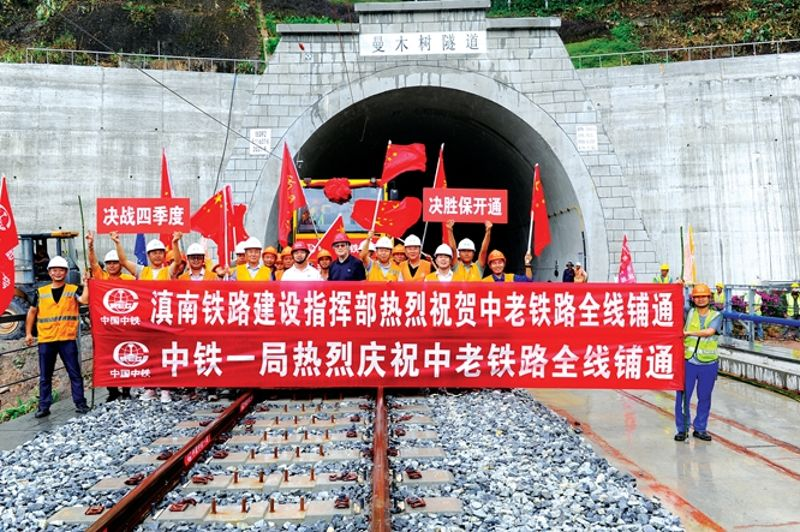Location:
Home > News Update > News Update
New Progresses in China-Laos Railway Construction
Source:
Date:2021年10月20日
Anthem of CREC—“Trailbreaker”
Track laying of the entire line completed
On October 12, at the exit of Manmushu Tunnel of China-Laos Railway in Mengla County, Xishuangbanna, southwest China’s Yunnan Province, the operators from China Railway First Group’s Xinyun Engineering Company drove a new type of long-track tractor, which was independently developed and manufactured by China, and accurately pushed the last set of 500-meter-long rails into place, marking the completion of track-laying for the entire line of China-Laos Railway linking Kunming in Yunnan with Laos’ capital city Vientiane.

China-Laos Railway is an important project for alignment of the China-proposed Belt and Road Initiative and Laos’ strategy of “transforming from a land-locked to a land-linked country.” It is also the first international railway which is mainly invested and built by China, adopts Chinese technical standards, uses Chinese equipment and is directly connected to China’s railway network. It consists of both Chinese section and Lao section, with a total length of more than 1,000 kilometers. After the cross-border railway is completed and opened to traffic, it will only take three-plus hours to travel from Kunming to Jinghong in Yunnan, and a train departing Kunming in the morning will arrive in Vientiane in the evening on the same day.
Completion of track paving of the entire line is a landmark progress in the construction of China-Laos Railway. Next, efforts will be made to promote track fine tuning, installation, and commissioning of four powered equipment, etc., in a bid to lay an important foundation for the trial run of motor trains and their launch and operation at the end of this year. At present, the interior decoration of 11 domestic passenger stations on China-Laos Railway is nearing completion, complimented by greening and gardening efforts in full swing. An “Iron and Steel Silk Road” of the new era is emerging to benefit people along the route and promote building of community of shared future for mankind.
Cold sliding test completed
On October 6, the cold sliding test for the four powered catenary project of the Boten-Vientiane section (Lao section) of China-Laos Railway, the first electrified railway in Laos, was completed at Vientiane South Station. The project was primarily undertaking by China Railway Eryuan Engineering Group and China Railway Wuhan Electrification Engineering Group, and its completion marked the basic completion of the contact network engineering project for the Lao section of China-Laos Railway and laid a foundation for the follow-up catenary power delivery and hot sliding.
The Boten-Vientiane section is a single-track electrified class-I railway with a total length of 414 kilometers and a design speed of 160 kilometers per hour. Ten traction substations are newly built and 576 kilometers of catenary lines are erected. Eighty percent of the line is located in mountainous and plateau regions with complex geological structure; and due to the influence of large faults and plate movements, earthquake disasters occur frequently. Therefore in the design, China Railway Eryuan Engineering Group put forward advanced design concepts and technologies such as seismic-resistant design of catenary and anti-lightning design in complex and dangerous mountainous areas, and cantilever suspension arrangement of catenary in low clearance tunnels, which demonstrated the strength of China’s railway construction.
Muong Sai Station inaugurated
On September 30 when its nameplate of the station was hung on the station, Muong Sai Station of China-Laos Railway was officially unveiled, which was built by China Railway Construction Engineering Group and located in the capital of Oudomxay Province.
Muong Sai Station, with a total construction area of 2,000 square meters, is a line-side station building with one platform for three lines. The station is located in the northern Lao area mainly inhabited by ethnic minorities. The design of the structure combines the local residence style with the typical architectural elements of traditional Chinese hip roof structures, featuring an ethnic appeal. The pillar heads are decorated in the traditional Chinese architectural form of “Dougong”, a bracket set, which gives people full visual enjoyment and embodies the integration of Chinese and Lao cultures.
The first-bid project of China-Laos Railway station buildings undertaken by China Railway Construction Engineering Group encompasses five station buildings (Boten Port, Na Teuy, Na Moh, Muong Sai and Mengla), four passing stations, as well as work and living facilities, totaling 75 single structures with a total space area of 68,900 square meters.
News Update
 New Progresses in China-Laos Railway Construction
New Progresses in China-Laos Railway Construction Polish President Visits CREC-made Shield Machine
Polish President Visits CREC-made Shield Machine CREC Wins New Fortune Best IR Hong Kong-listed Company (A+H)...
CREC Wins New Fortune Best IR Hong Kong-listed Company (A+H)... CREC Attends China-Africa Economic and Trade Expo
CREC Attends China-Africa Economic and Trade Expo World’s Largest Steel and Concrete Girder Cable-stayed Brid...
World’s Largest Steel and Concrete Girder Cable-stayed Brid... CREC Attends the First International Summit on BDS Applicati...
CREC Attends the First International Summit on BDS Applicati... CREC Wins the‘Nobel Prize’ in the Global Engineering Consu...
CREC Wins the‘Nobel Prize’ in the Global Engineering Consu... CREC's ESG Case Selected into "ESG Practice Cases of Listed ...
CREC's ESG Case Selected into "ESG Practice Cases of Listed ... China's First Intelligent TBM‘Snow Pioneer’Sets Sail
China's First Intelligent TBM‘Snow Pioneer’Sets Sail An Arterial Thoroughfare Paved in Kyrgyzstan
An Arterial Thoroughfare Paved in Kyrgyzstan CREC Once Again Receives China’s Highest Quality Award
CREC Once Again Receives China’s Highest Quality Award China Railway Eryuan Engineering Group Wins 2021 FIDIC Award...
China Railway Eryuan Engineering Group Wins 2021 FIDIC Award... The World’s Largest Diameter TBM Launched in Georgia
The World’s Largest Diameter TBM Launched in Georgia Construction Completed for Medical Device Industrial Park in...
Construction Completed for Medical Device Industrial Park in... China Railway No.8 Engineering Group Helps Congo-Brazzaville...
China Railway No.8 Engineering Group Helps Congo-Brazzaville...


